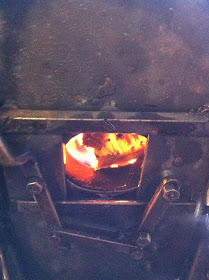Pictured below is the rear wheelset; freshly painted, tyre polished and with new axleboxes fitted as previously reported. For some reason the boxes were completely free when outside the engine, but when tightened up inside they were getting tight, as if they were being pulled out of centre. After checking the fit inside the horn guides and the square on the horns themselves, all seemed OK so it had to be the boxes, or something similar...
It was later discovered that the R/H keep plate on the R/H new axlebox had a slight drilling/tapping error on one of the spring holders. This meant that, when tightened into the frames, the keep plate stopped the misaligned spring holder from being able to pivot ever so slightly with the box during movement. This pulled the box ever so slightly over to one side, thus misaligning the axle a wee bit and causing a slight tight spot. So, I opted to remove the springs and keep plate and just slightly open up the holes to relieve the tension. Perhaps a bodge in the eyes of some, but in my eyes a bodge that will not cause the engine any problems other than to ensure that her new axleboxes do not get damaged or run hot...
Moving on to May 22nd and the coupling rods were receiving their attention. After a few different means of making them clear the wheels and the crossheads failed, we decided to flute them at the back, as per standard gauge practise. Therefore, 10-thou (0.25mm) spacers were made for each bearing to sit in front of, and a further 10-thou was fluted into the back of each coupling rod in order to ensure a good clearance. This work was completed the following week on May 29th, though in the meantime an incident did occur. The final of the four connecting rods to be fluted had an unfortunate falling out with a large endmill in the milling machine that was fluting it, and thus ended up with one of the oil pots snapped completely off and half of the decorative frontage chewed away. Though the actual integrity of the rod was by no means compromised, the rod did need some cosmetic surgery as it were. The rod was delicately made up with soft weld and then ground down to a perfectly uniform oil pot again. Even I struggle to imagine it is a repair, and I must thank some good friends of mine for patching up the rod for me: its now good as new and refitted to the engine. So, a good evenings work yesterday (29th) saw the engine back together and ready for a test steaming, with both of the rods and the newly opened up axlebox keep ready for action. Today after work all I had to do was refit the eccentrics for the double-acting axlepump and then refit the grate ready for a steam up. After all of the necessary checks were carried out and water was pumped into the boiler, the locomotive had her first fire lit in over 4 months...
 |
| "First Fire since January" |
The locomotive is pictured here blocked up and in steam. I operated her for about an hour ticking over, both at higher and lower pressures. In the end she steamed right down to about 2psi on the clock before stopping so not bad considering she's on a few new bearings again. Regular checks were of course made whilst she was in steam in order to ensure that everything was taking oil correctly and that nothing was running warm. I am pleased to say that, apart from the tanks leaking (not enough sealant around one or two nuts!), the engine ran very well and I am very pleased with her...




No comments:
Post a Comment
I Always Welcome Comments On My Blog. I Look Forward To Hearing From You...